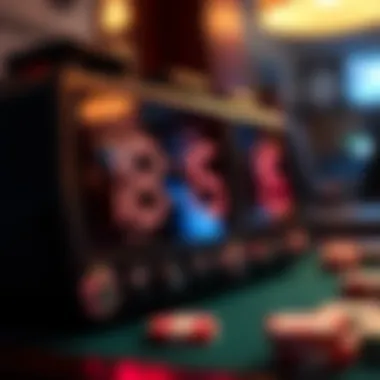The Impact of Poker Timer Clocks on Game Dynamics


Intro
Poker timer clocks have become an integral component of modern gambling, sculpting the way games are played across various formats. Their significance extends far beyond mere timekeeping; they can completely reshape player dynamics, strategies, and even the atmosphere at the table. Players, whether seasoned pros or enthusiastic newcomers, must understand how these devices influence gameplay, decision-making, and pacing. As we explore the functionalities, evolution, and applications of poker timers, we will uncover how they can enhance both recreational and professional experiences.
The landscape of poker has dramatically shifted with the introduction of timer clocks, transforming a once leisurely pastime into a calculated battleground where every second counts. Players need to adapt their strategies based on the timer's settings and behaviors, ensuring they are always one step ahead. This article aims to dissect the various facets that contribute to a comprehensive understanding of poker timer clocks, diving into their operational mechanics and how they dictate the rhythm of the game.
As we journey through this exploration, we’ll touch on popular betting strategies, game variations, timer settings, and the intricate relationship between time management and player decisions. By examining the role that timing plays in these different elements, readers will be provided with valuable insights that can directly enhance their game.
Let's get started.
Prelims to Poker Timer Clocks
In the fast-paced world of poker, where every second counts, the integration of timer clocks into gameplay has revolutionized how players approach strategy, decision-making, and even tournament structure. This section will uncover the substantial importance of poker timer clocks, focusing on their role in establishing a well-regulated and engaging atmosphere at the table. By understanding the mechanics and purpose of these timers, players can enhance their performance while ensuring the game proceeds smoothly and fairly.
Defining Poker Timer Clocks
Poker timer clocks serve as essential tools that control the duration of each player's turn, as well as the overall pace of play during cash games and tournaments. These devices come in various configurations, from digital timer models that display countdowns in bright LED formats to mechanical timers that evoke a nostalgic sense of tradition.
Despite their diverse appearances, all poker timer clocks primarily aim to:
- Ensure all players have equal time to make decisions
- Maintain a steady game pace that prevents prolonged delays
- Deter stalling tactics that could upset the flow of the game
The underlying principle here is straightforward – by defining and regulating the amount of time players have to act, these clocks help cultivate a competitive yet enjoyable gaming environment.
Historical Context
As poker evolved from informal gatherings in dimly-lit rooms to high-stakes tournaments broadcast across the globe, the need for standardized rules regarding time management became increasingly apparent. Early games relied solely on verbal cues or implicit understandings among players regarding how long one could take to act. However, this led to inconsistencies and frustrations that could sour the gaming experience.
In the late 20th century, as poker's popularity surged—especially with televised tournaments—several poker rooms and organizers began adopting rudimentary timer systems. The first equipment resembled simple stopwatches that players would operate themselves. Gradually, advancements in technology ushered in digital timers, allowing poker venues to implement more complex configurations, such as Round Timers that automatically adjust as the game progresses.
Moreover, the evolution of mobile applications has significantly contributed to the accessibility of timer clocks, allowing players to adapt their usage based on personal preference or house rules.
"The integration of timer clocks not only emphasizes the strategic elements of poker but also reflects a growing commitment to fairness and professionalism in the game."
Understanding the historical context provides insight into how these tools came to hold such a pivotal place in modern poker. They not only define play dynamics but also cater to the expectations of today’s discerning poker players who demand efficiency without sacrificing the spirit of the game.
Types of Poker Timer Clocks
Understanding the diverse range of poker timer clocks is integral to grasping how they enhance gameplay. Various timer models fill distinct niches within the poker world, each offering unique functionality and advantages. As we delve into the specifics of these types, we can better appreciate their significance in facilitating smoother play and better player experiences.
Digital Timer Models
Digital poker timers have become the go-to choice for many tournaments and casual games alike. They come equipped with a myriad of features that can cater to the specific needs of different formats. For instance, players can easily tailor the countdown settings and increments to suit their playing style. One notable example of a digital timer is the Timer by Poker Timer Pro, which allows players to set their time limits and includes audible alerts, ensuring players stay on track.
The key benefits of digital timer models include:
- Ease of Use: Digital interfaces are typically straightforward, making it easy to set and adjust times.
- Precision: Digital clocks provide accurate countdowns that help in minimizing disputes over time.
- Versatility: Many digital clocks can be configured for various types of games—be it Texas Hold'em, Omaha, or any other.
Overall, the flexibility and clarity offered by digital timers position them as the essential device for efficient gameplay in both home games and official tournaments.
Mechanical Timer Variants
Mechanical timer clocks, albeit less popular in the age of technology, still hold a place in many poker circles. These timers often evoke a sense of nostalgia among traditional players. Mechanical models, such as the Duke Timer, rely on physical mechanisms to keep time, emphasizing a tactile interaction that digital models cannot replicate.
Some advantages of mechanical timers include:
- Durability: They tend to last longer as they don't depend on batteries or electrical components.
- Aesthetic Appeal: Many players appreciate the classic look of mechanical clocks, as they add a touch of elegance to the game setup.
However, it is important to note their limitations. Mechanical timers often require manual adjustments, which could lead to errors, particularly in games where moments count. Nonetheless, their charm remains undeniable for some veteran players who relish the tangible click of gears as time ticks away.
Mobile Applications
With the advent of smartphones, mobile applications have emerged as a popular alternative to traditional poker timers. Apps like Poker Timer offer the convenience of portability and can often be downloaded for free or at a low cost. Players simply need their smartphones, making setup a breeze.


The advantages of using mobile applications for poker timing include:
- Portability: Players can easily carry them anywhere, making them a travel-friendly option.
- Customizability: Many apps allow for extensive customization, so players can set up various scenarios—such as tournament structures or blind increases.
- Notifications: Mobile applications can send push notifications, alerting players when their time is about to expire.
However, players must ensure their devices are sufficiently charged, as a dead battery can lead to chaos at the table.
Key Takeaway: The choice between digital timer models, mechanical variants, and mobile applications ultimately comes down to players' preferences and game settings. Each type offers unique benefits that can cater to different playing environments and styles.
Whether it be an intricately designed mechanical timer or a robust mobile app, the right choice can significantly influence the overall flow of the game.
Understanding the Mechanics of Poker Timers
In the realm of poker, a game that blends strategy, psychology, and luck, understanding the mechanics of poker timers becomes essential. These tools are pivotal in shaping the dynamics of gameplay, ensuring a structured and balanced experience for players. Timer clocks are not merely gadgets that count down seconds; they serve various roles that enhance the overall integrity and flow of poker games.
To grasp the significance of poker timers, one must appreciate how they control game pace, stimulate player engagement, and minimize unnecessary delays. Delving into the operational functions of these devices allows for a deeper comprehension of their impact on player behavior and decision-making processes.
Basic Functionality
At its core, the basic functionality of poker timer clocks revolves around tracking time for each player. These clocks often feature displays that visibly indicate how much time remains for a player's turn, fostering a sense of urgency.
Common aspects of these devices include:
- Countdown Mechanism: This fundamental aspect underscores every poker timer. Once a player begins their turn, the clock starts ticking down. If the player doesn’t act before the time runs out, they may face penalties, such as automatic folding or losing the ability to make certain moves.
- Sound Indicators: Many modern timers incorporate audio signals to alert players when they have limited time left. This can help keep players on their toes. It’s a small aspect that can dramatically boost the pace of the game.
- Multiple Timers: In tournament settings, timers might be set to account for levels of play, adjusting the time allowed based on various stages of the tournament. This aspect ensures fairness by scaling up the stakes and allowing for deeper strategic play as the game matures.
Understanding these functions is crucial for players who want to navigate the competitive landscape effectively, leveraging the timer to enhance their strategic decisions and manage their gameplay efficiently.
Timer Settings and Configuration
The ability to configure timer settings is central to optimizing gameplay, particularly in more competitive environments. Depending on the game format—whether it's a cash game or tournament—players can adjust the timer settings to better suit their preferences or the needs of the game. Here are some considerations for configuring timers:
- Setting Time Limits: Players might have the option to set time limits for individual turns, which can range anywhere from a mere 20 seconds to several minutes. This flexibility allows players to choose how quickly they wish the game to unfold.
- Incremental Timer Features: Some players prefer timers that allow for increments, where time gets added to their clock after taking an action. This feature is beneficial in high-stakes games where every second counts and players can strategize around their available time.
- Adjusting Intervals: In tournament play, intervals between blind increases are critical. Proper configuration of timer settings can ensure that these intervals align with the game flow, maintaining both challenge and engagement.
Benefits of Using Poker Timer Clocks
Poker timer clocks bring multiple advantages to the gaming table, and understanding these benefits is crucial for both players and organizers. They not only streamline gameplay but also enhance the overall experience for participants. Not to mention, they foster a spirit of fairness that resonates well within the poker community. Below, we will delve deeper into how these timer clocks are instrumental in improving game pace, focus, and fairness.
Enhancing Game Pace
One of the most notable benefits of using poker timer clocks is their ability to increase the speed of play. In a world filled with distractions, keeping players engaged and the game flowing is paramount. Timer clocks eliminate the notorious "slowroll"—a term used for the act of delaying a decision unnecessarily—which can frustrate opponents and halt the game.
By imposing strict time limits for each decision, poker timer clocks ensure that players are constantly moving. It can be eye-opening to compare a game with a timer against one without. The former has a rhythmic tempo that keeps participants on their toes, whereas the latter can often drag on, leading to fatigue and reduced enjoyment.
"Time waits for no one," as they say in poker. Timed games encourage participants to think quickly and act purposefully, creating an environment where strategy and swift judgment are key.
Improving Player Focus
In addition to enhancing game pace, poker timer clocks serve to sharpen player concentration. When faced with a ticking clock, players tend to become more attuned to their surroundings and the dynamics of the game. This heightened awareness can lead to more strategic plays and insightful decisions, as each participant harnesses their mental acuity under time constraints.
Moreover, the use of a timer helps curb distractions such as chit-chat and off-topic conversations that can easily derail a session. In a four-hour tournament, having defined phases supported by a timer can create a focused atmosphere, leading to a better experience overall. The clock serves not just as a guide, but as a constant reminder for players to remain present in the game.
Facilitating Fair Play
Fairness is at the core of any competitive environment, and poker timer clocks play a vital role in maintaining it. Without a timer, situations can arise where some players may benefit from taking excessive time for their decisions, while others might feel pressured to act quickly. Such discrepancies can lead to feelings of resentment and claims of unfair advantage.
Using a timer standardizes decision-making processes across all players. Everyone has the same amount of time to weigh their options and act, leveling the playing field. This is especially important in tournament settings, as it ensures that every participant is given equal opportunity to showcase their skills.
Strategic Applications of Poker Timers
In the ever-evolving landscape of poker, where every second counts and strategic precision can spell the difference between triumph and defeat, the application of poker timer clocks transcends mere functionality. These devices not only orchestrate game pacing but also influence players' strategies and decision-making processes. By mastering timer management, players can align their actions to the ebb and flow of the game, developing skills that elevate them from mere participants to formidable opponents.
Time Management in Gameplay
In poker, time management equates to opportunity management. Players who grasp the nuances of timing—be it in action selection, betting rounds, or game phases—often find themselves in favorable positions.


Timers impose a structure on gameplay, compelling players to make decisions within set intervals. This can lead to a variety of tactical approaches:
- Pacing Adjustments: Knowing the timer adds an urgency to decision-making. A player might choose aggressive plays during critical hands, using limited time to project confidence and instill uncertainty in opponents.
- Practice and Preparation: Familiarity with timer settings can streamline a player's routine, enabling them to execute strategies smoothly under pressure. In essence, regular practice under timed conditions translates into sharper instincts during actual gameplay.
- Targeting Specific Players: Understanding when opponents struggle with time pressure provides invaluable insight. For instance, a player who hesitates during high-stakes bets can become a target for pressure tactics, forcing them into uncomfortable decisions.
Ultimately, efficient time management arms players with not just speed, but also control. It elevates their overall game, allowing for a calculated balance between risk and reward.
Adapting Strategies Based on Timer Settings
Strategies in poker are as dynamic as the game itself. With varying timer settings, players must adapt their gameplay to suit the current structure, maximizing their chances of outsmarting opponents.
- Short Timers: A clock that imposes short time limits can spur reckless decisions. Here, a player might employ a more aggressive strategy, making bold bets to capitalize on opponents' panic and rushed choices. It’s a game of cat and mouse, where even small bluffs can yield substantial rewards.
- Long Timers: Conversely, longer time frames allow for deeper analysis and nuanced decision-making. A player might dissect opponent behaviors, evaluating each play with greater scrutiny. This encourages thoughtful strategies involving situational plays that exploit weaknesses over time.
- Optimizing Bet Sizes: Adapting to timer settings also extends to the psychological aspect; players can leverage the time remaining to fine-tune their betting tactics. For example, an all-in bet with just seconds remaining can be more intimidating than a similar move under prolonged pressure, forcing opponents into high-stakes decisions.
In both scenarios, the art of adjusting to timer settings embodies the spirit of poker—instinct and intellect interwoven in a dance with chance and calculated risks.
"In poker, it's not just about the cards you hold, but how well you can play the hand you’re dealt within the ticking clock of fate."
Understanding the strategic applications of poker timer clocks not only enhances gameplay but equips players with a toolkit capable of adapting to varying scenarios. This agility is what often separates the elite from the average, demonstrating that time, when wielded wisely, can be just as potent as the cards themselves.
For additional insight, check out resources available at Reddit and Wikipedia.
Whether you're a seasoned pro or a novice, recognizing the implications of timer clocks can foster improved strategies that lead to wins at the table.
Influence of Timer Clocks on Player Decisions
The impact of timer clocks in poker cannot be overstated. These essential tools shape how players approach decisions, manage their time, and adapt their strategies. With the right timing mechanisms in place, judgment calls can transform from mere gut feelings to calculated moves based on pressure and pacing. Understanding this influence is crucial for anyone looking to elevate their game.
Psychology of Time Pressure
Time pressure plays a significant role in the psychological landscape of poker. Players find themselves in high-stress situations where the clock ticks against them, amplifying emotions like anxiety and urgency. A tick-tock rhythm can either motivate a player to act swiftly or cause hesitation. Ultimately, the psychological burden of time can make or break a hand.
Studies suggest that the presence of a timer can lead to an increase in impulsive decisions, particularly among novice players who may not be used to the feeling of urgency. The intensity of the moment can push players to base their decisions on instinct rather than careful consideration.
This phenomenon can be particularly pronounced in tournament settings where every second holds more weight. Players may feel the hot breath of competition on their necks, leading them to check or raise without thoroughly evaluating their options.
In contrast, experienced players often harness the anxiety induced by the clock to sharpen their focus. They learn to balance speed and accuracy, using time constraints to gauge their opponents’ reactions. When being pressed by timers, they may pick up on subtle body language hints, such as fidgeting or stalling, which inform their strategies.
Decision-Making Under Time Constraints
The dance between time pressure and decision-making underlines an important aspect of poker. When players face dwindling seconds, their responses can be vastly different from situations with ample time. In high-stakes games, the luxury of reflection gives way to instinctive choices at critical moments.
Several aspects come into play when time constraints tighten.
- Speed vs. Accuracy: Players must quickly balance their need for speed with the accuracy of their decisions. One often leads to the other. Favoring speed might mean missing details, while taking too long could result in a missed opportunity or worse—an automatic fold.
- Emotional State: The emotional weight of the game escalates as the timer dwindles. Players may feel pressure not just from their own stakes but also from the palpable tension surrounding them. Emotions, often unmoored in such instances, can cloud judgment.
- Game Readiness: Some players thrive under pressure, using the urgency to fuel their tactical thinking, while others buckle down, forced into rash choices. Good players acknowledge this difference and adjust their strategies accordingly.
- Context Awareness: Recognizing when to expedite a decision, based on game dynamics and timing, becomes a critical skill. An astute player will recognize when a countdown is likely to provoke an error from an opponent, taking advantage of that momentary lapse.
Comparative Analysis of Timer Clock Usage
When examining the role of poker timer clocks, it’s crucial to compare their usage across different settings. This comparative analysis sheds light on how the context—whether a tournament or cash game, or even online versus live environments—shapes the application and impact of these timers on gameplay. Each setting offers unique dynamics and considerations, influencing everything from pace to player decisions.
Tournaments vs. Cash Games
In a tournament setting, poker timer clocks serve a vital function. Players are typically faced with limited chip stacks which can create a heightened sense of urgency. This is where timers come into play, ensuring that players make quick decisions within defined periods. The atmosphere can be intense, leading players to feel the pressure of the clock pressing on them.
- Structured Time Limits: In tournaments, timers help enforce round limits, pressing players to make decisions swiftly and keep the game flowing. With each level increase, the complexity and pressure typically grows, compelling players to recalibrate their strategies.
- Blinds and Antes: As blinds escalate, tournament timers not only dictate the pace but also accentuate the stakes involved. Players strategizing their next move must account for increasing stakes and limited time, which often results in a tighter gameplay style as they adapt to time constraints.
Conversely, cash games function differently. Here, players can buy in for different amounts and have more flexibility. The pressure of a ticking clock isn’t as pronounced.
- Dynamic Flow: Cash games allow for longer periods of indecision. Timers may still be employed, but they often set more leeway, permitting players to engage more deeply in each hand.
- Real-time Strategy Adjustments: Flexibility allows for real-time adjustments based on table dynamics. Here, decisions can be less hurried, as the pressure of tournament-like time constraints is removed.
Both settings have unique requirements that shape player behavior and strategy. The tournament environment engenders a high-pressure situation demanding rapid decision-making, whereas cash games can leverage the absence of strict time constraints to enable richer strategic engagements.
Online vs. Live Games
The distinction between online and live games in the context of poker timer clocks is equally striking. Online platforms often rely heavily on timers for several reasons:


- Automation of Time Management: Online poker rooms automatically handle timer enforcement, keeping players on a tight schedule. This reduces the chance of players "taking a breather" and prolonging decisions that can lag the game.
- Multitabling Flexibility: Many online players engage in multiple tables simultaneously. Timers help ensure they stay alert and responsive across games without losing track of their play.
On the other hand, live games create a different tempo:
- Social Interactions: In-person play often features social dynamics, where timeliness can be less rigid. Players often engage in conversations or banter, allowing for a more leisurely pace. The human element fundamentally alters how timers are perceived and utilized.
- Physical Cues and Environment: Decisions in live games might take longer due to physical reads and the atmosphere of the poker room. Players may place significant value on observing opponents, which can lengthen decision time.
Ultimately, understanding these differences is essential for grasping how timer clocks can enhance or challenge player decision-making. Recognizing the nuances provides insights into player psychology and game theory, without underestimating the complexity inherent in different poker environments.
Trends in Poker Timer Technology
The landscape of poker timer technology is fast-evolving, much like the game itself. Players, whether casual or professional, are increasingly recognizing the necessity of staying updated with developments that improve gameplay and experiences. As innovations crop up, timer clocks are no longer just about counting down; they’re morphing into sophisticated systems that enhance strategy and user experience. This article dives into two significant trends shaping the future of poker timer technology: emerging features and integration with gaming software.
Emerging Features in Timer Clocks
As poker continues to adapt to modern demands, timer clocks are being fitted with a host of new features designed to cater specifically to player needs. Here are some noteworthy examples:
- Customizable Time Limits: Players can now set personalized time limits to suit their play styles or tournament needs. This flexibility allows for a more tailored gaming experience.
- User-Friendly Interfaces: Modern timers come with sleek and intuitive displays, making it easy for players to track their time without complex navigation. Clarity is essential during high-stakes moments.
- Pause Functionality: This feature lets players momentarily halt timing, which can be crucial for situations needing interruptions, like rule clarifications or disputes.
- Visual and Audible Alerts: Timers now offer visual cues and sounds as players approach their time limits, keeping them on their toes and enhancing the strategic gameplay.
- Multiple Table Management: For those multi-tabling, some advanced timer systems allow management of different timers across various tables simultaneously.
Each of these features contributes to making gameplay smoother and more engaging, addressing the nuances of player preferences. The more seamless the experience, the better it is for everyone involved.
Integration with Gaming Software
An increasingly prominent trend in poker timer technology is its integration with gaming software. This marriage of technologies ensures that timers are not standalone devices but are instead part of a larger ecosystem that enhances gameplay. Here are a few critical benefits of this integration:
- Real-Time Updates: Through integration, players can receive dynamic updates related to game status, such as blinds increases or remaining time, directly from the software interface.
- Data-Driven Insights: Advanced systems can analyze player behavior and timing patterns, providing insights that help players refine their strategies and enhance their overall gameplay.
- Synchronization Across Platforms: Whether it's live or online play, timers can be synchronized with central game management systems, ensuring consistency across different gaming venues.
- Flexibility in Game Types: Integrated timer systems can accommodate various game formats, whether it be Texas Hold'em, Omaha, or any other variant, seamlessly adjusting based on the game rules and requirements.
- Enhanced Social Interactions: Modern gaming platforms often include features that allow players to engage with one another, making gameplay a more social experience where timers play a vital part.
Challenges and Considerations
As one delves into the world of poker timer clocks, it becomes increasingly evident that while these devices enhance gameplay significantly, they also bring forth a series of challenges and considerations that players and tournament organizers must navigate. Understanding these hurdles is key to ensuring that timer clocks serve their intended purpose without detracting from the player experience.
Technical Limitations of Timer Clocks
One of the foremost concerns with poker timer clocks involves their technical limitations. While many models boast impressive features, they may not always deliver a seamless experience. Here are some common technical issues to consider:
- Battery Life: Many digital timers rely on batteries, and the lifespan of these batteries is often unpredictable. A sudden battery failure could lead to disruptions in a tournament, resulting in frustration among players.
- Lag and Response Time: Some timer clocks may experience lag in their response times, causing discrepancies in the countdown. In a game where every second counts, this can create tensions that affect player decisions.
- User Interface Complexity: Not all timer clocks are user-friendly. A complicated interface could lead to errors in setting or resetting the timer, which in turn impacts the overall flow of the game.
Considering these elements is crucial, as the effectiveness of a timer clock is directly tied to its reliability and ease of use. In worst-case scenarios, such as a malfunction during crucial moments of a game, it can lead to disputes among players or even jeopardize the integrity of the competition.
Potential Impact on Player Experience
The way timer clocks are integrated into gameplay can have profound implications on player experience. Here are a few ways in which poorly implemented timer mechanisms could sour the competitive atmosphere:
- Stress Induction: While a sense of urgency can heighten tension in poker, excessive time pressure can lead to anxiety. Players may feel rushed to make decisions, potentially leading to suboptimal plays. This can particularly affect less experienced players who might not be accustomed to the rapid pace.
- Game Integrity: If players sense that timer operations are inconsistent or unfair, it can lead to distrust among competitors. Maintaining a fair environment is paramount; hence, adequate calibration and testing of timer clocks become necessary before use in tournaments.
- Disruptions in Flow: Frequent adjustments or glitches in timer clocks can interrupt the natural flow of the game, leaving players feeling disjointed or distracted. Continuous interruptions can break focus and lead to a less enjoyable experience overall.
Consequently, addressing these challenges isn't just about improving the timer clocks themselves but also involves ensuring that the surrounding tournament structure can adapt. It's a delicate balance; the goal should always remain focused on facilitating an environment where players can engage fully and strategically, unhindered by technical malfunctions or undue pressure.
End on Poker Timer Clocks
In the world of poker, where decisions are made and moments are precious, the role of poker timer clocks cannot be overstated. These devices influence not only the rhythm of the game but also the strategies employed by players. By maintaining the tempo, they ensure that the games flow smoothly, preventing stagnation and allowing players to engage actively and competitively.
Summarizing Key Insights
Throughout this exploration, several pivotal insights emerged.
- Pacing the Game: Timer clocks help manage the time players take for their moves. This pacing keeps the energy alive at the table, contributing to a dynamic atmosphere that both recreational and professional players appreciate.
- Enhancing Strategy: Understanding timer settings allows players to tailor their strategies effectively. The way a player manages their time can directly relate to their decision-making and game outcomes. A player who can adapt to quick judgments may outmaneuver a player who struggles under pressure.
- Fair Play Maintenance: Timer clocks provide a level playing field. Ensuring that all players have the same time allotment for their decisions prevents any unfair advantages based on time discrepancies.
In essence, the introduction of timer clocks has revolutionized the game, making it more engaging and structured. They’ve shifted the dynamics from leisurely play toward a more competitive environment, appealing to a broad audience.
Future Directions
As technology continues to evolve, the future of poker timer clocks appears promising. Here are a few trends and directions to keep an eye on:
- Integration with Advanced Software: Future tournament setups may see deeper integration of timer clocks with gaming software. This could include features that adapt based on player behavior or game fluctuations, ultimately enhancing the experience both at the table and online.
- Customization Options: Advanced customizable timer settings could allow players to alter their time management strategies more finely. Such flexibility might cater to varying styles and pace preferences, accommodating both fast-paced and strategic gameplay.
- AI-Powered Timers: We could see the advent of AI-enabled timers that analyze game flow in real-time and adjust settings accordingly. By monitoring patterns, these tools may help players optimize their performance and strategy.
By continuing to evolve, poker timer clocks will not only shape the game’s future but also ensure the experience remains riveting and fair for all.
"The clock is a tool, but it’s the player who must learn to master it."
As the landscape of poker technology evolves, the importance of understanding and optimizing time management will likely become a hallmark of skilled play.







